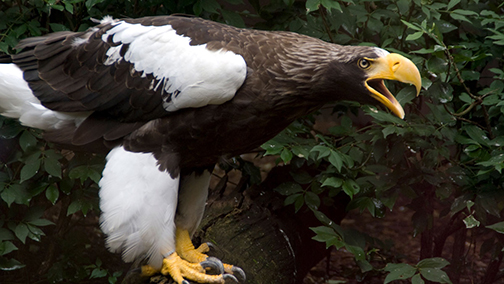by Tim Crosby
CARBONDALE, Ill. – Nature embraces order. So, when a cool bird shows up where it’s not supposed to be, it can be a big win for both local economies and nature lovers, say researchers at Southern Illinois University Carbondale, who recently studied the impact of a lone Steller’s sea eagle that somehow found its way to and across North America a few years ago.

The bird in question, whom birders dubbed “Stella,” had wandered almost 7,000 miles away from home. Stella was first spotted in Alaska in August 2020 before making its way (Stella’s sex is still unknown) to Texas in March 2021 and then to eastern Canada later that year.
In winter of 2021, Stella took up residence in Maine and Massachusetts, drawing bird-watchers and curiosity seekers for miles around before moving on to Nova Scotia. Its latest known location is Newfoundland.
Brent Pease, assistant professor, along with Kofi Akamani, associate professor, both in the School of Forestry and Horticulture, set out to quantify how such a bizarre – but natural – occurrence impacts the human-nature nexus. Their findings appear today (Sept. 12) in the journal People and Nature.
One big bird
A striking raptor with an enormous wingspan of up to 8 feet, Stella was bound to make an impression on the bird-watching community when it showed up so far from home. Steller’s sea eagles’ normal range includes parts of Asia such as eastern Russia, China, Korea, Japan and in the Sea of Okhotsk and the Bering Sea. Its population is declining, with an estimated 4,000 birds in the wild.
Even though reports of birds so far off course – biologists call them “vagrants” – are fairly common, Pease said, Stella stirred up an unusual amount of interest, with message boards and social media lighting up.
“My involvement started as a spectator – it was wild to hear folks traveling across the country to see this bird,” Pease said. “But then my research brain kicked in, and I thought to quantify the economic impact it was having on tourist towns during what is usually the off-season.”
The bird buzz was impossible to ignore, Pease said, with enthusiasts assigning it nicknames and even creating a Twitter (now X) account on its behalf. The fact that the COVID-19 pandemic was at its height during that time also seemed to add to the excitement.
“It kind of seemed like the perfect storm – people were feeling cooped up from COVID restrictions, and this was something to get excited about,” Pease said. “So many folks decided to chase the bird across the country.”
A supporter of citizen science, Pease felt he had to move quickly, as it was uncertain how long the bird would be around. He started by creating a survey hosted on Survey Monkey circulated on various social media platforms aimed at measuring individuals’ attempts to see Stella.
“I wanted to make sure I was working on it while the news was on folks’ mind,” Pease said.
“We eventually used eBird to track sighting reports, and we mined Twitter for all tweets about it. We were trying to find out as much information about who was going to see the eagle, and how much they were spending to get there.”
A vagrant by any other name…
Birders have long been fascinated with so-called vagrant birds, Pease said. They consider them to be a once-in-a-lifetime chance to add a new bird to one’s life list of observed species. It’s a hot enough pursuit that folks who chase such opportunities have their own label within the birding community: “twitchers.”
Scientists think errors in the birds’ internal compasses, wind drift, overshooting mistakes during migrations or extreme weather might account for their visits to new locales.
“It can even be natural dispersal behavior in search of a new home,” Pease said. “A fun way to look at it is a bird in search of love.”
Whatever the reasons, when a large, charismatic species such as this one arrives, so often do the tourism dollars.
Pease and Akamani’s study asked people to estimate how much money they spent to travel and view the eagle. They also used a method called “willingness to pay” to estimate how much the spectators’ experience was worth to them beyond the money they already spent on travel.
Results indicated that among the estimated 2,115 to 2,645 people who made the trip, the average person spent $180 (excluding travel time) or $277 (including travel time) to see the bird. Those numbers meant Stella generated between $380,604 and $476,626 of total spending, or $584,373 to $731,809 when travel time was considered.
“We also estimated that people were hypothetically willing to pay an additional $139,036 and $174,114 to see the eagle,” Pease said. “These hypothetical spending dollars are considered the conservation potential of the species, where people would donate some amount of money to a birding nonprofit to protect the species.”
Lessons learned
The research highlights the importance of assessing nature’s contributions to people, helping stakeholders make decisions about conservation, Pease said. Even rare birds that show up only occasionally can be important, albeit short-lived, economic boosts for communities if people come to see them and spend money, Pease said.
“By showing that there is an economic benefit to preserving bird habitats and promoting birdwatching tourism, our research can help people make better decisions about how to protect nature and derive its benefits in an increasingly unpredictable world that is marked by land use change, climate change impacts and other forces of social and ecological change,” he said.
